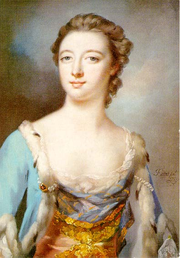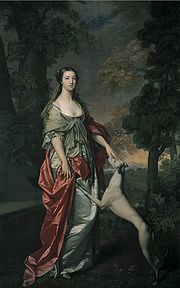
Elizabeth Campbell, 1st Baroness Hamilton
Encyclopedia


Circa
Circa , usually abbreviated c. or ca. , means "approximately" in the English language, usually referring to a date...
December 1733 – December 20, 1790) was a celebrated Irish
Irish people
The Irish people are an ethnic group who originate in Ireland, an island in northwestern Europe. Ireland has been populated for around 9,000 years , with the Irish people's earliest ancestors recorded having legends of being descended from groups such as the Nemedians, Fomorians, Fir Bolg, Tuatha...
belle and society hostess.
Early life
Born Elizabeth Gunning in Hemingford GreyHemingford Grey
- Location:It is situated on the southern bank of the River Great Ouse in the county of Cambridgeshire, with the northern bank occupied by the flood meadow. Until 1965 it was in Huntingdonshire and between 1965 and 1974 it was in the short-lived county of Huntingdon and Peterborough...
, Huntingdonshire
Huntingdonshire
Huntingdonshire is a local government district of Cambridgeshire, covering the area around Huntingdon. Traditionally it is a county in its own right...
, she was the daughter of John Gunning of Castle Coote, County Roscommon
County Roscommon
County Roscommon is a county in Ireland. It is located in the West Region and is also part of the province of Connacht. It is named after the town of Roscommon. Roscommon County Council is the local authority for the county...
and his wife, Hon. Bridget Bourke, daughter of Theobald Bourke (1681–1741), 6th Viscount Mayo. Elizabeth's elder sister was Maria Gunning.
In late 1740 or early 1741, the Gunning family returned to John Gunning's ancestral home in Ireland
Ireland
Ireland is an island to the northwest of continental Europe. It is the third-largest island in Europe and the twentieth-largest island on Earth...
, where they divided their time between their home in Roscommon, and a rented house in Dublin. According to some sources, when Maria and her sister Elizabeth came of age, their mother urged them to take up acting in order to earn a living, due to the family's relative poverty. The sources further state that the Gunning sisters worked for some time in the Dublin theatres, befriending actors like Margaret Woffington, even though acting was not considered a respectable profession as many actresses of that time doubled as courtesans to wealthy benefactors. However, other sources differ and point out that Margaret Woffington did not arrive in Dublin until May 1751, by which time Maria and her sister Elizabeth were in England.
In October 1748, a ball was held at Dublin Castle
Dublin Castle
Dublin Castle off Dame Street, Dublin, Ireland, was until 1922 the fortified seat of British rule in Ireland, and is now a major Irish government complex. Most of it dates from the 18th century, though a castle has stood on the site since the days of King John, the first Lord of Ireland...
by the Viscountess Petersham. The two sisters did not have any dresses for the gathering until Tom Sheridan, the manager of one of the local theatres, supplied them with two costumes from the green room, those of Lady Macbeth
Lady Macbeth
Lady Macbeth may refer to:*Lady Macbeth, from William Shakespeare's play Macbeth**Queen Gruoch of Scotland, the real-life Queen on whom Shakespeare based the character...
and Juliet
Juliet
Juliet is one of the title characters in William Shakespeare's tragedy Romeo and Juliet, the other being Romeo. She is the daughter of old Capulet, head of the house of Capulet. The story has a long history that precedes Shakespeare himself....
. Wearing the costumes, they were presented to the Earl of Harrington
Earl of Harrington
Earl of Harrington is a title in the Peerage of Great Britain. It was created in 1742 for the former Secretary of State and then Lord President of the Council, William Stanhope, 1st Baron Harrington. He had already been created Baron Harrington, of Harrington in the County of Northampton, in 1730,...
, the then Lord Lieutenant of Ireland. Harrington must have been pleased by the meeting as, by 1750, Bridget Gunning had persuaded him to grant her a pension, which she then used to transport herself, Maria, and Elizabeth, back to their original home in Huntingdon, England. With their attendance at local balls and parties, the beauty of two girls was much remarked upon. They became well-known celebrities, their fame reaching all the way to London, and themselves following soon afterwards. On December 2, 1750, they were presented at the court of St James. By this time, they were sufficiently famous that the presentation was noted in the London newspapers.
Elizabeth was immortalized in portraits by, among others, artists Sir Joshua Reynolds
Joshua Reynolds
Sir Joshua Reynolds RA FRS FRSA was an influential 18th-century English painter, specialising in portraits and promoting the "Grand Style" in painting which depended on idealization of the imperfect. He was one of the founders and first President of the Royal Academy...
http://www.liverpoolmuseums.org.uk/ladylever/collections/elizabethgunning.asp and Gavin Hamilton
Gavin Hamilton (artist)
Gavin Hamilton was a Scottish neoclassical history painterwho is more widely remembered for his hunts for antiquities in the neighborhood of Rome...
http://www.rcahms.gov.uk/hamilton/longgallery24.html.
Marriage into nobility
In January 1752, Elizabeth met the Duke of Hamilton. According to WalpoleRobert Walpole
Robert Walpole, 1st Earl of Orford, KG, KB, PC , known before 1742 as Sir Robert Walpole, was a British statesman who is generally regarded as having been the first Prime Minister of Great Britain....
, on 14 February (St. Valentine's Day) at a party at Bedford House, the duke declared his desire to marry Elizabeth that night and he called for a local parson
Parson
In the pre-Reformation church, a parson was the priest of an independent parish church, that is, a parish church not under the control of a larger ecclesiastical or monastic organization...
to perform the ceremony. However, without a license, calling of banns
Banns of marriage
The banns of marriage, commonly known simply as the "banns" or "bans" are the public announcement in a Christian parish church of an impending marriage between two specified persons...
, and a ring, the parson refused. They were eventually married that night in Mayfair Chapel (which did not require a license) in a clandestine marriage, with a ring from a bed-curtain, whereupon Elizabeth became the Duchess of Hamilton.
When the duke died in 1758, she became engaged to the Duke of Bridgwater
Francis Egerton, 3rd Duke of Bridgewater
Francis Egerton, 3rd Duke of Bridgewater , known as Lord Francis Egerton until 1748, was a British nobleman, the younger son of the 1st Duke...
but the engagement was cancelled that year for reasons unknown. On 3 February the following year she married John Campbell, Marquess of Lorne
John Campbell, 5th Duke of Argyll
Field Marshal John Campbell, 5th Duke of Argyll , styled Marquess of Lorne from 1761 to 1770, was a Scottish soldier and nobleman.-Military career:...
.
From 1761 to 1784, she was a Lady of the Bedchamber
Lady of the Bedchamber
This is an incomplete list of those who have served as Lady of the Bedchamber in the British Royal Household...
to Queen Charlotte
Charlotte of Mecklenburg-Strelitz
Charlotte of Mecklenburg-Strelitz was the Queen consort of the United Kingdom as the wife of King George III...
. Her husband later succeeded to his father's title of Duke of Argyll
Duke of Argyll
Duke of Argyll is a title, created in the Peerage of Scotland in 1701 and in the Peerage of the United Kingdom in 1892. The Earls, Marquesses, and Dukes of Argyll were for several centuries among the most powerful, if not the most powerful, noble family in Scotland...
in 1770, and Elizabeth became known as the Duchess of Argyll. On 20 May 1776, King George III
George III of the United Kingdom
George III was King of Great Britain and King of Ireland from 25 October 1760 until the union of these two countries on 1 January 1801, after which he was King of the United Kingdom of Great Britain and Ireland until his death...
, a long time admirer of hers, created her Baroness Hamilton of Hameldon
Baron Hamilton of Hameldon
The title Baron Hamilton of Hameldon, of Hambledon in the County of Leicester, is a title created in the Peerage of Great Britain in 1776. It was created for Elizabeth Hamilton , Duchess of Hamilton, wife since 1752 of James Douglas-Hamilton, 6th Duke of Hamilton...
in her own right.
Children
She had three children from her first marriage with the Duke of Hamilton:- Lady Elizabeth Hamilton (26 January 1753 – 14 March 1797), married Edward Smith-Stanley, 12th Earl of DerbyEdward Smith-Stanley, 12th Earl of DerbyEdward Smith-Stanley, 12th Earl of Derby PC , styled Lord Strange between 1771 and 1776, was a British peer and politician of the late 18th and early 19th centuries...
- James Douglas-Hamilton, 7th Duke of Hamilton (18 February 1755 – 7 July 1769)
- Douglas Douglas-Hamilton, 8th Duke of Hamilton (24 July 1756 – 2 August 1799)
She had five children from her second marriage with the Duke of Argyll:
- Lady Augusta Campbell
- George John Campbell, Earl of Campbell (1763–1764)
- George Campbell, 6th Duke of ArgyllGeorge Campbell, 6th Duke of ArgyllGeorge William Campbell, 6th Duke of Argyll GCH, PC , styled Earl of Campbell from 1768 to 1770 and Marquess of Lorne from 1770 to 1806, was a Scottish Whig politician and nobleman.-Background:...
(1768–1839) - Lady Charlotte CampbellCharlotte BuryLady Charlotte Susan Maria Bury was an English novelist, who is chiefly remembered in connection with a Diary illustrative of the Times of George IV .-Life:...
(1775–1861) - John Campbell, 7th Duke of ArgyllJohn Campbell, 7th Duke of Argyll-External links:...
(1777–1847)
Titles and styles
- birth – 14 February 1752: Miss Elizabeth Gunning
- 14 February 1752 – 17 January 1758: HG The Duchess of Hamilton
- 17 January 1758 – 3 February 1759: HG The Dowager Duchess of Hamilton
- 3 February 1759 – death: HG The Duchess of Argyll
- 20 May 1776 – death: The Rt Hon. The Baroness Hamilton of Hameldon
Honours
Lady of the BedchamberLady of the Bedchamber
This is an incomplete list of those who have served as Lady of the Bedchamber in the British Royal Household...
, 1761–1784
Later life
Elizabeth died on December 20, 1790 at her home of Argyll House in LondonLondon
London is the capital city of :England and the :United Kingdom, the largest metropolitan area in the United Kingdom, and the largest urban zone in the European Union by most measures. Located on the River Thames, London has been a major settlement for two millennia, its history going back to its...
and was buried at Kilmun
Kilmun
Kilmun is a linear settlement on the north shore of the Holy Loch in Argyll and Bute, Scotland. It runs between the head of the loch and connects with the village of Strone at Strone Point, where the loch joins the Firth of Clyde....
, Argyllshire.
Sources
- The Peerage
- The Two Beautiful Misses Gunning
- The Gunning Sisters
- Undone by Virginia Henley
- Horace Beakley, The Story of a Beautiful Duchess, published 1907

